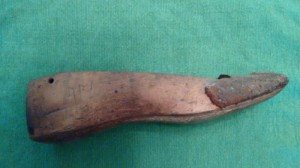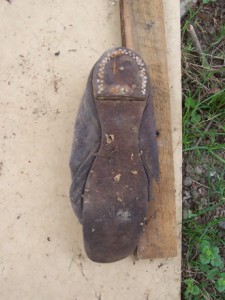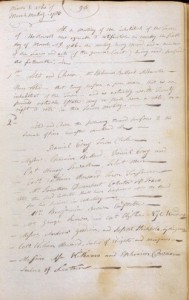When Chicken Little said the sky was falling, I did not take that to mean corsets and shoe lasts. I’ve learned while restoring and renovating my old house that the unexpected is to be expected, that making a change here means a ripple effect of changes there, and that what goes up must come down, usually when I’m not expecting it.
When our carpenters were working on the original back staircase, everything seemed to fall out of the old ceiling: square hand-cut nails, buttons, a hand-cut wooden spoon, a wooden shoe last, some small bones I’d rather not discuss, but not one bag of Colonial-era coin, no now-priceless daily diaries.
The shoe last is interesting if not wholly exciting because the gentleman who built this house, Asa Williams (1758–1820), was a cordwainer, or shoe maker. It makes sense to me that if he could make shoes he could also repair them, but in various extant records he is called a cordwainer, not a cobbler (one who repairs shoes). He was also a tanner as well as the town’s “sealer of leather,” making sure that leather was sold for honest quality and quantity.
 The man knew his leather and his shoes. For any one customer, Asa would have made two shoes exactly the same using a straight last; left and right shoes weren’t common until sometime after the mid-1800s. There are shoemakers today who make Colonial era shoes for re-enactors; some of those shoes are straight last shoes which do not conform to the shape of the foot. Try walking in them sometime: not such happy feet! My old shoe last is hand-cut of wood, carved with the initials “D.R.S.,” sports a carved instep and a spot of felt or leather along the toes to help conform new leather to an old foot, and is a curved last for a woman’s right foot: i.e., it was used for a pair of left and right shoes. Without doubt Asa did not make or use this last, but because he undoubtedly passed his knowledge on to his son, perhaps Asa Jr. also made shoes, perhaps for a local lady whose initials are “D.R.S.”
The man knew his leather and his shoes. For any one customer, Asa would have made two shoes exactly the same using a straight last; left and right shoes weren’t common until sometime after the mid-1800s. There are shoemakers today who make Colonial era shoes for re-enactors; some of those shoes are straight last shoes which do not conform to the shape of the foot. Try walking in them sometime: not such happy feet! My old shoe last is hand-cut of wood, carved with the initials “D.R.S.,” sports a carved instep and a spot of felt or leather along the toes to help conform new leather to an old foot, and is a curved last for a woman’s right foot: i.e., it was used for a pair of left and right shoes. Without doubt Asa did not make or use this last, but because he undoubtedly passed his knowledge on to his son, perhaps Asa Jr. also made shoes, perhaps for a local lady whose initials are “D.R.S.”
 The latest artifact to appear came out of a chimney closet wall under repair and is a man’s leather shoe with no apparent inclination as to left or right foot. The heel sports enough nails to defy time and surely it has. Unfortunately, the shoe did not withstand whatever chewed on it, a subject I also refuse to consider.
The latest artifact to appear came out of a chimney closet wall under repair and is a man’s leather shoe with no apparent inclination as to left or right foot. The heel sports enough nails to defy time and surely it has. Unfortunately, the shoe did not withstand whatever chewed on it, a subject I also refuse to consider.
This straight-last man’s shoe is possibly one of Asa’s handmade shoes, and an example of the old British custom of hiding single, worn out shoes around chimneys, under floors, above ceilings, or around doors and windows to ward off evil, witches, and those ghoulies and ghosties of children’s prayer fame, or to bestow fertility on a female member of the house. (It might have worked: Asa and Eunice had nine children, and their daughter Elizabeth W. Hamlen had five.) If the shoe was indeed hidden around that chimney for any superstitious custom, it is an interesting addition to Asa’s reputation as a devout Protestant and his position in the local meetinghouse as tythingman, a church member who enforced attendance at Sunday services. It was also his duty to assure wakefulness during notoriously long sermons by tickling the noses of sleeping offenders with a feather attached to one end of a staff, or knocking them on the head for a second offense with the knob at the staff’s other end. (I suppose he could have just thrown a shoe at them.)
Even though most of our restoration has been completed (only two more ceilings to go!), I am eagerly but warily anticipating whatever falls down, hard hat at the ready. Chicken Little has nothing on this house.
Share this:

About Jan Doerr
Jan Doerr received a B.A. degree in Sociology/Secondary Education from the University of New Hampshire, and spent a long career in the legal profession while researching her family history. She has recently written and published articles for WBUR.org’s Cognoscenti blog: “Labor of Love: Preserving a 226-Year-Old Family Home and Preparing to Let It Go” and “The Value of Family Heirlooms in a Digital Age.” Jan currently lives with her attorney husband in Augusta, Maine, where she serves two Siamese cats and spends all her retirement money propping up a really old house.View all posts by Jan Doerr →
